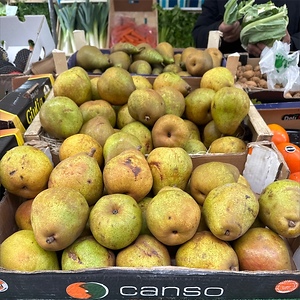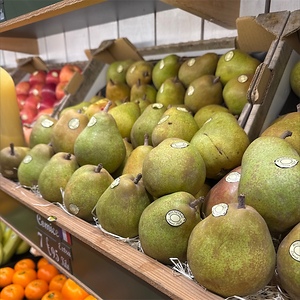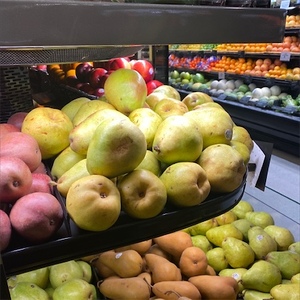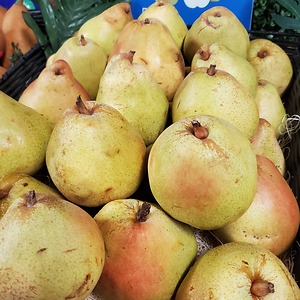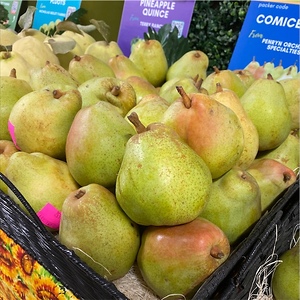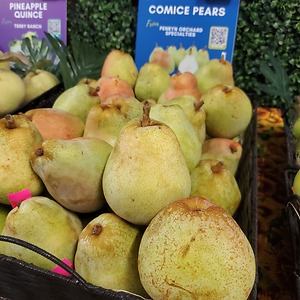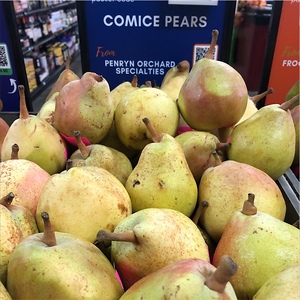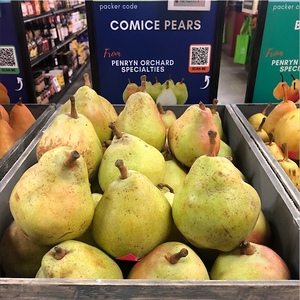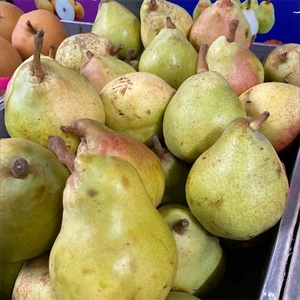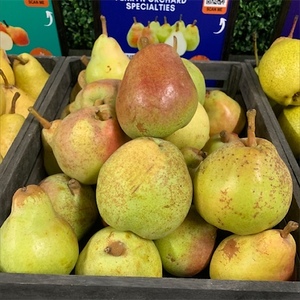

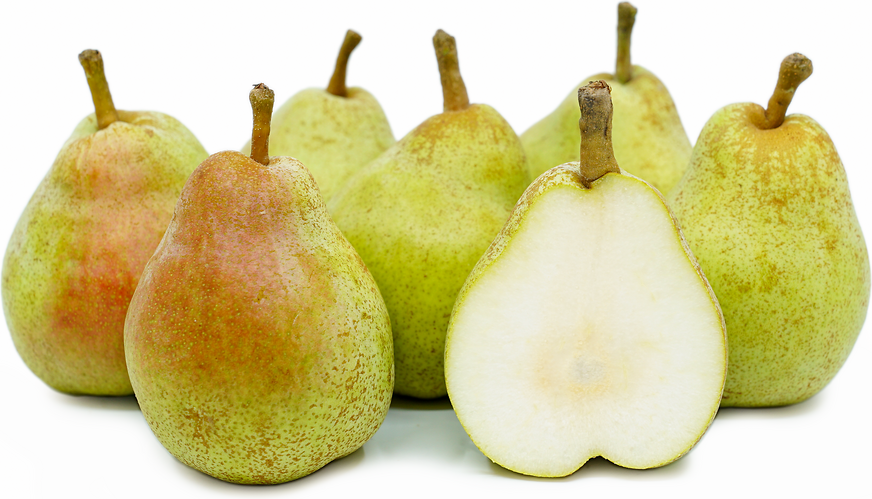
Comice Pears
Estimated Inventory, 25 lbs : 0
This item was last sold on : 01/13/25
Description/Taste
Comice pears vary in size, depending on cultivation conditions, but are generally a larger varietal, averaging 7 to 10 centimeters in diameter. The fruits have a distinct shape comprised of a bulbous, curved base and a short, defined neck. Comice pears also bear a thick, fibrous, and woody brown stem, and small patches of russet surround where the stalk connects to the fruit. The variety’s skin is thin, smooth, taut, and delicate, showcasing green and yellow hues at maturity. The skin also features muted red blush on sides exposed to ample amounts of sun during cultivation and prominent grey-brown lenticels. Comice pears notably have fragile skin when ripe and are easily bruised when handled roughly during harvest. These bruises may not immediately appear on the surface but can show up over time with ripening. Though the exterior may be bruised, it may not always impact the quality of the flesh. Comice pears have white to ivory flesh and develop a semi-firm, tender, fine-grained, and aqueous texture with a succulent nature when ripe. The flesh also encases a small, slender core that extends through the center of the fruit. Comice pears are edible raw and release a perfumed, sweet, and floral aroma. To determine when the fruits are ripe, check the pear’s neck. If it is soft under gentle pressure, the fruit is ready for consumption. Ripe Comice pears have a mild, sweet, and tangy flavor with subtle floral and fruity nuances.
Seasons/Availability
Comice pears are traditionally harvested in the fall and are stored for a period to develop a softer texture and sweeter flavor. After this storage period, they are released for sale in the winter and spring.
Current Facts
Comice pears, botanically classified as Pyrus communis, are a French variety belonging to the Rosaceae family. The mid to late-season pears are categorized as a winter variety and are one of France's most commercially grown pears. Comice pears are known for their tender, fine-grained flesh, sweet taste, and perfumed flavor. The variety is sought by chefs and home cooks for culinary purposes and is particularly favored for fresh eating. Since its discovery, Comice pears have expanded in cultivation throughout France and have also spread worldwide in commercial and home orchards. Comice pears grow on wide-spreading, branching trees reaching three meters in height and can be grown to standard, semi-dwarf, or dwarf sizes, depending on the rootstock. They are also a hardy, drought-tolerant, and long-living variety. In some commercial markets, the pears are known under their full name, Doyenné Du Comice. This name has been shortened over time in markets to Comice. In the modern day, Comice pears have remained a premium seasonal fruit and are still regarded as one of the best European varieties for fresh consumption.
Nutritional Value
Comice pears are a source of fiber to stimulate digestion and vitamins C and K to strengthen the immune system and aid in faster wound healing. Pears also provide minerals such as potassium, copper, iron, calcium, and magnesium. Potassium balances fluid levels within the body, while copper helps to produce red blood cells. Iron develops the protein hemoglobin for oxygen transport through the bloodstream, magnesium controls nerve functions, and calcium supports bones and teeth. Other nutrients found in pears include folate, riboflavin, and boron.
Applications
Comice pears have a sweet flavor suited for raw and cooked preparations. The variety’s soft, melting texture shines when served ripe on cheese boards and other appetizer platters. Comice pears are also sliced and tossed into green salads, diced and mixed into fruit medleys, or chopped and combined with fresh herbs in nuts as a simple side. Try consuming Comice pears on their own as a snack, wrapping in prosciutto and watercress as a bite-sized dish, or serving the fresh pear slices with nut butter, cream cheese, or yogurt-based dips. Comice pears are also blended into smoothies, green juices, cocktails, and other fruit beverages worldwide. In addition to fresh preparations, Comice pears are occasionally sauteed in butter. Once cooked, the pear slices are topped with cheese and roasted nuts as a simple appetizer. Comice pears can also be baked into crumbles, cakes, tarts, and clafoutis or used as fillings in various pastries. In France, Comice pears are famously poached in rich sauces, wine, and spiced syrups to create simple but impactful desserts. Poires Belle Helene is a well-known poached pear in chocolate sauce, and it was a dessert allegedly created by chef Auguste Escoffier in Paris during the 19th century. Comice pears are also used in classic tarts, including tarte bourdaloue, and simmered into compotes, jams, and sauces. Beyond sweet dishes, Comice pears are incorporated into ham and cheese gratins, grilled sandwiches, or roasted to accompany meat main dishes. Comice pears are often served with spices such as cardamom, cinnamon, anise, and turmeric, raisins, nuts including almond, hazelnut, pine, pecans, and chestnuts, herbs such as mint, rosemary, and cilantro, maple syrup, and cheeses including camembert, gorgonzola, blue, and brie cheese. Whole, unwashed Comice pears will keep for several weeks when stored in a perforated bag in the refrigerator’s crisper drawer. If the fruits need to be ripened, they should be left at room temperature. Once the desired maturity has been reached, pears should be kept in the refrigerator to prevent further ripening.
Ethnic/Cultural Info
Comice pears were named after Comice Horticole, a horticultural society in the Angers region of France who allegedly first discovered the variety in one of their gardens. Throughout their history, Comice pears have acquired several monikers, including the “fruit of the kings” and “Christmas pears.” There is little information available about the use of Comice pears in the late 19th and early 20th centuries beyond records in catalogs and horticultural journals, but since their commercial release, the variety has been popular among local French lore as a choice fruit among royalty. These connections to nobility have nicknamed the pears “the fruit of the kings,” and their initial rarity and seasonal availability contributed to their premium status. Comice pears were also elevated as signature pears during the winter holiday season. Companies in Europe and the United States heavily market the variety in ornate gift boxes and elaborate packaging as a luxury gift for family, friends, and business partners during Christmas. Harry and David, a famous American premium food retailer, sells a variety of Comice pear labeled under the name Royal Riviera pears. These pears are wrapped in gold foil and reach their peak season during the holidays. They are also highly favored for their size, texture, and flavor and have become a well-known “Christmas pear” seasonally purchased in the winter.
Geography/History
Comice pears are native to France and were discovered in the mid-19th century in the Jardin du Comice in Angers, a garden now called the Jardin des Beaux-Arts. It is believed that Comice Horticole, a local horticultural group, planted pear trees in their Angers garden but did not record what variety they established. Several years later, a young pear tree was noticed in the garden and began producing fruit in 1848. The fruit was evaluated among the horticultural group and was noted to be a new type of pear. After the discovery, naturalists Hilaire Dhommé and Pierre-Aimé Millet de la Turtaudière were involved in studying the new fruits, and the pears were featured a year later in 1849 at the Angers Horticultural Festival under the name Doyenné Du Comice. The variety was documented in several French nursery catalogs throughout the early 1850s, and in 1852, Comice pears were sent to the United States for potential commercial planting. By 1858, Comice pears were widely accepted among French growers, and the variety was adopted for cultivation in England and other regions of Europe, where it became a favored home garden and commercial cultivar. Comice pears were also named “the best pear in the world” by the London Horticultural Journal in 1894 and have been featured in writings throughout the late 19th and 20th centuries. Today, Comice pears are primarily grown in Europe, North America, and Australia. When in season, Comice pears are sold through fresh markets, specialty grocers, wholesalers, and online retailers.
Recipe Ideas
Recipes that include Comice Pears. One
Podcasts



